Abstract
1. Completely isolated identified neurones from the right parietal ganglion of the pond snail Lymnaea stagnalis were investigated under two-electrode voltage clamp. Neuronal nicotinic acetylcholine receptor (AChR) currents were studied at low acetylcholine concentrations (< or = 200 nM). 2. Inhibition of the ACh-induced currents by three volatile general anaesthetics (halothane, isoflurane and methoxyflurane) and the specific inhibitor (+)-tubocurarine was studied as a function of temperature (over the range 4-25 degrees C). 3. The inhibition by the volatile anaesthetics increased (inhibition constants decreased) with decreasing temperature while the inhibition by (+)-tubocurarine did not change significantly near room temperature, but decreased at lower temperatures. The (+)-tubocurarine inhibition appeared to be competitive in nature and showed no significant voltage-dependence. 4. The van't Hoff plots (logarithms of the dissociation constants against reciprocal absolute temperature) were linear for the anaesthetics, but markedly non-linear for (+)-tubocurarine. From these plots, values for the changes in the standard Gibbs free energy delta G degrees water-->AChR, enthalpy delta H degree water-->AChR, entropy delta S degree water-->AChR and heat capacity delta Cp degree water-->AChR were determined. Tubocurarine was found to bind very much tighter to the receptor than the volatile anaesthetics due, entirely, to a favourable increase in entropy on binding. 5. A comparison between the temperature-dependence of the anaesthetic inhibition of the ACh receptor and that of general anaesthetic potencies in animals indicates that the temperature-dependence of animal potencies might be simply accounted for in terms of changes in anaesthetic/receptor binding.
Full text
PDF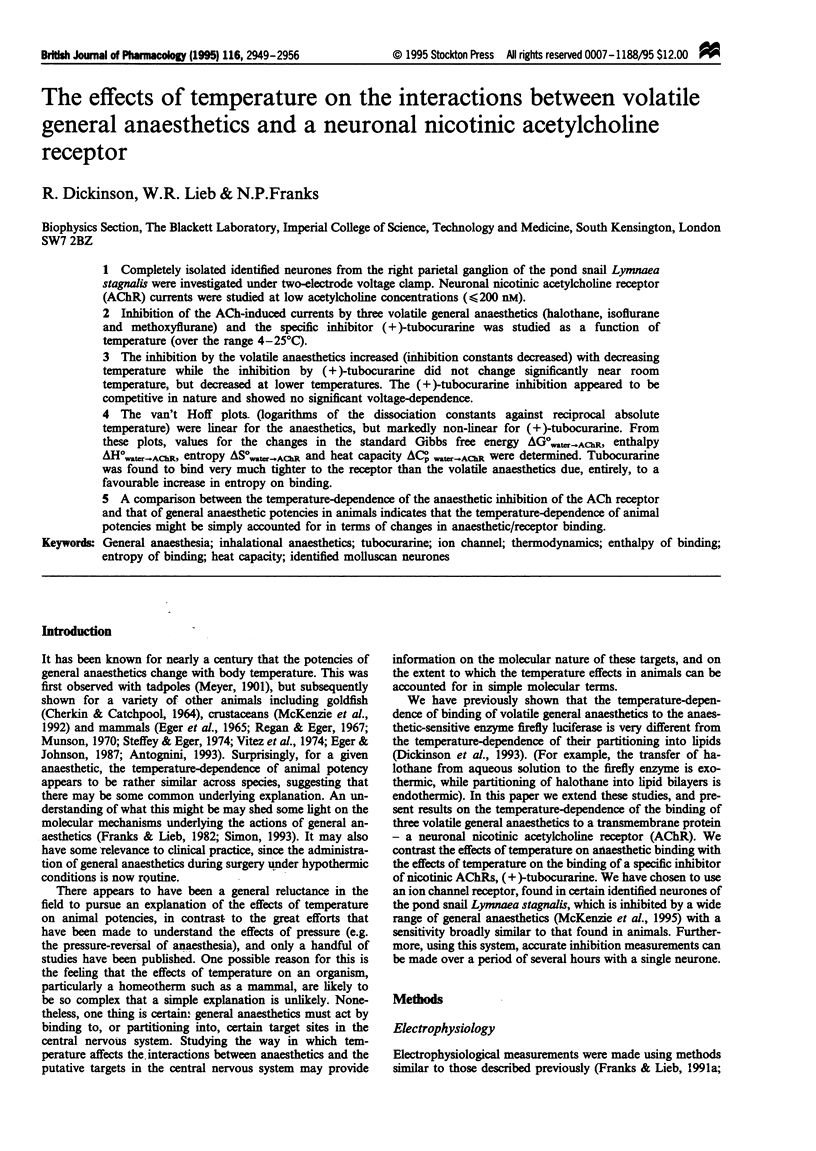
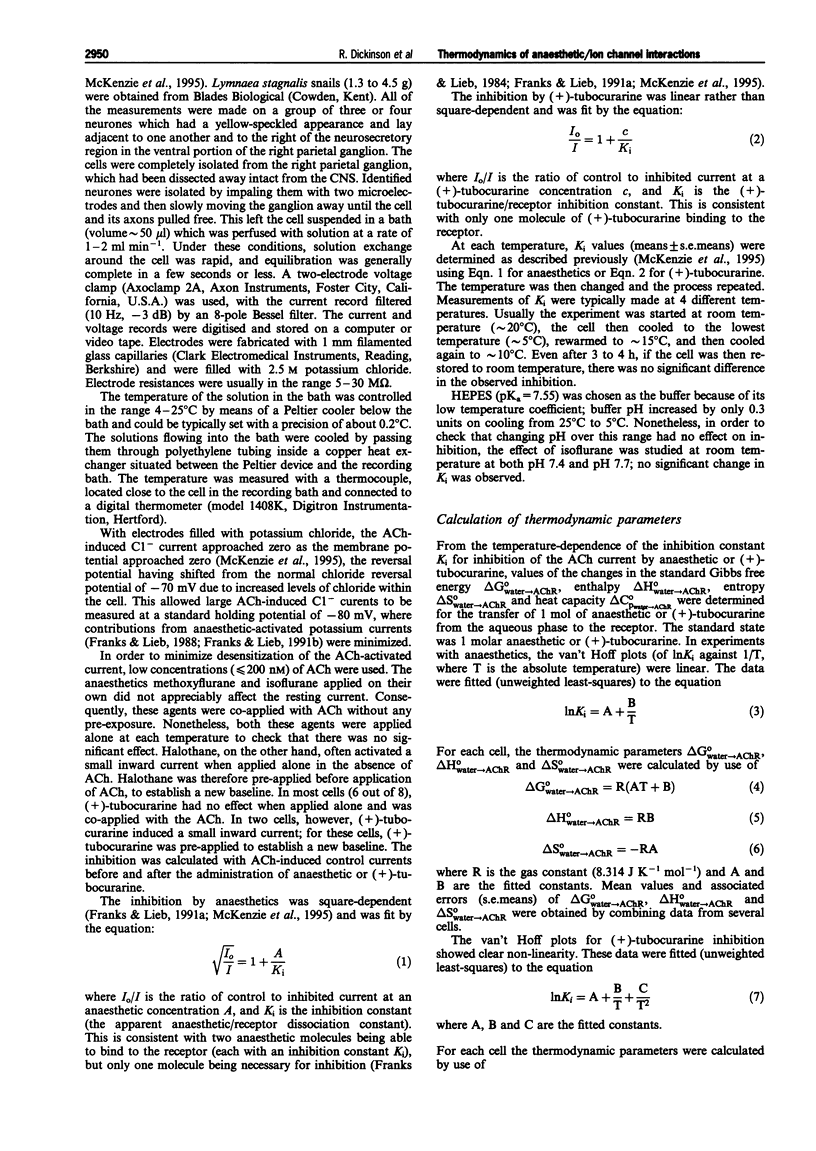
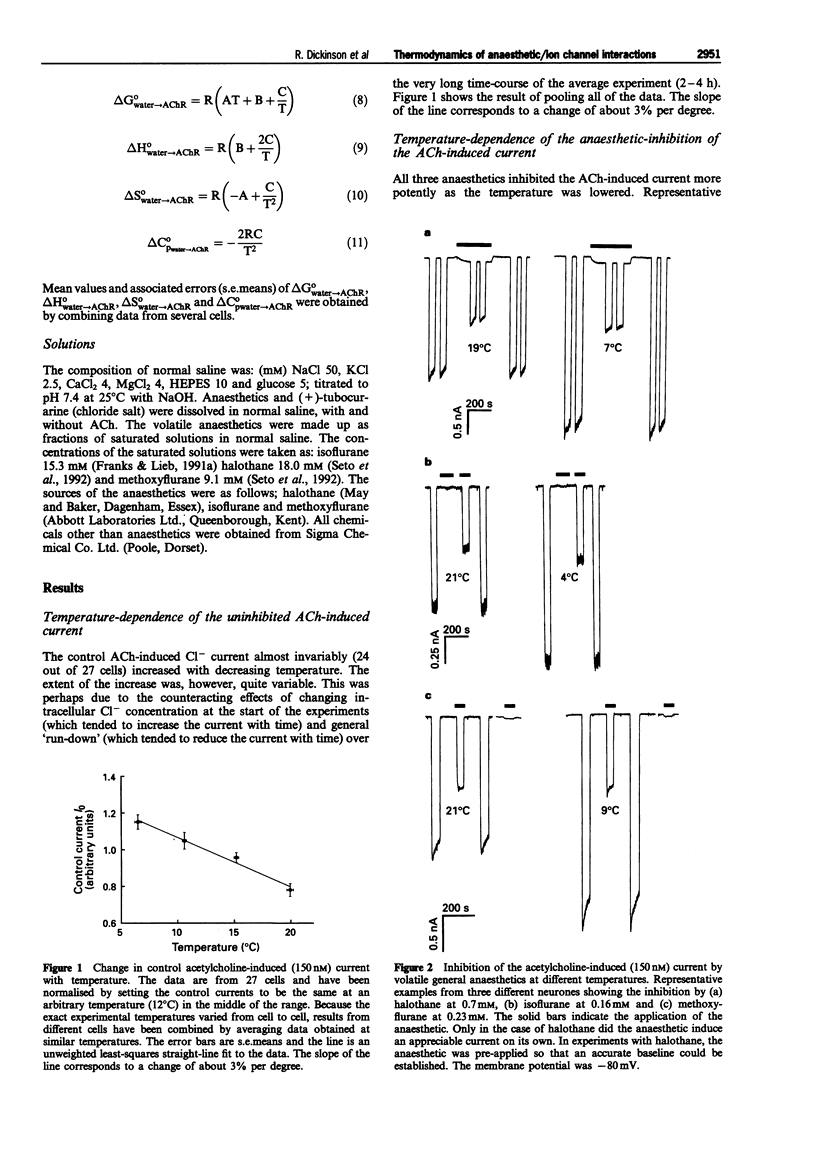
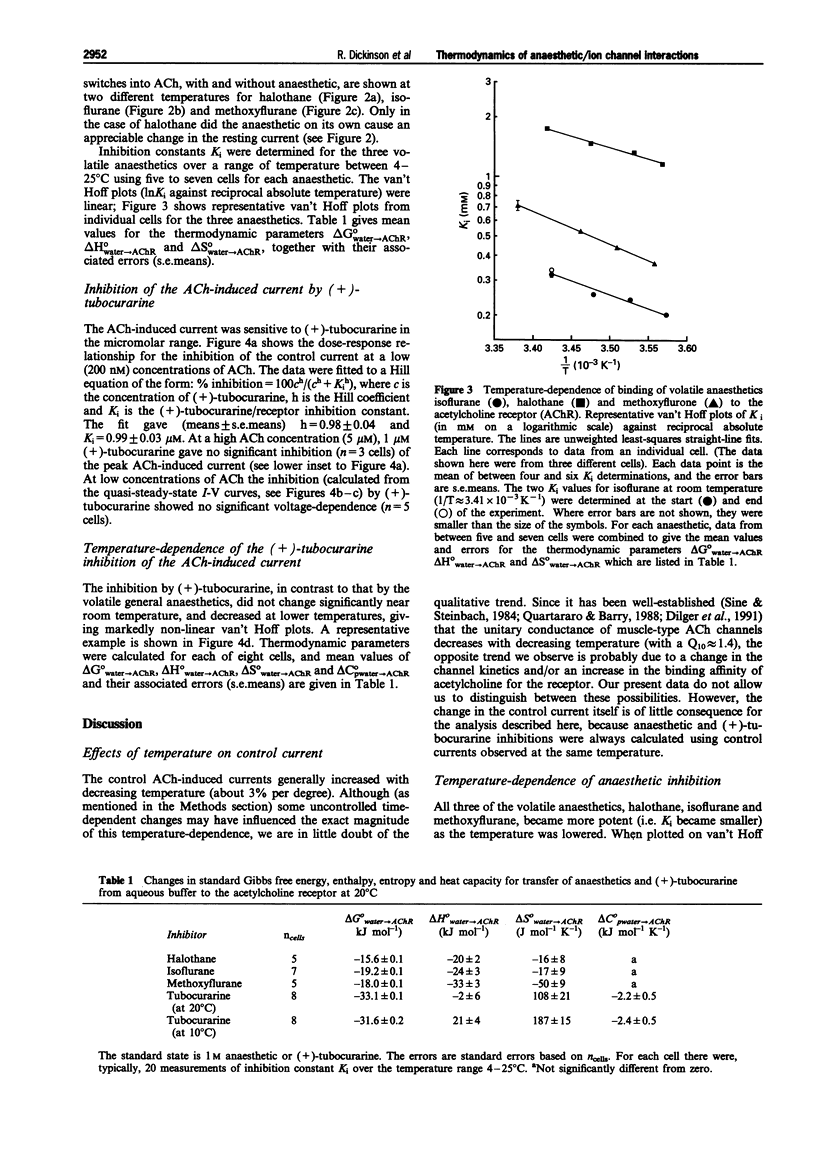
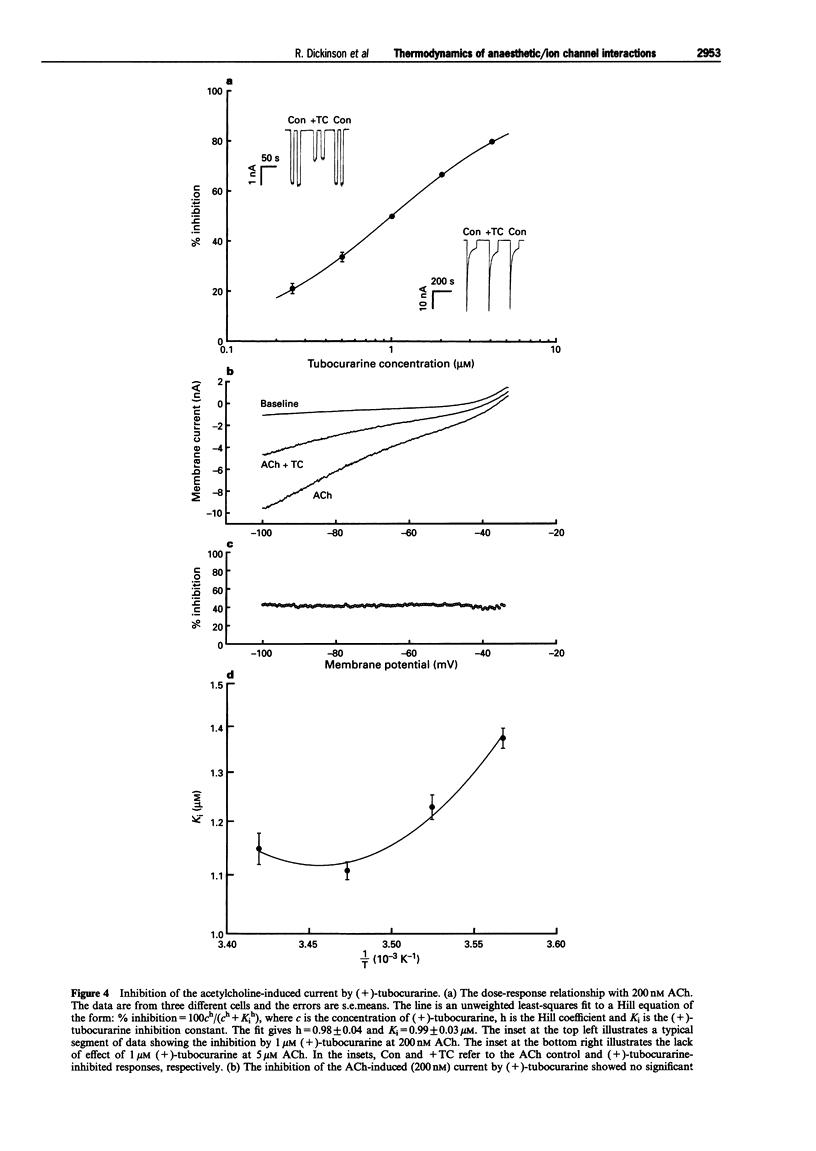
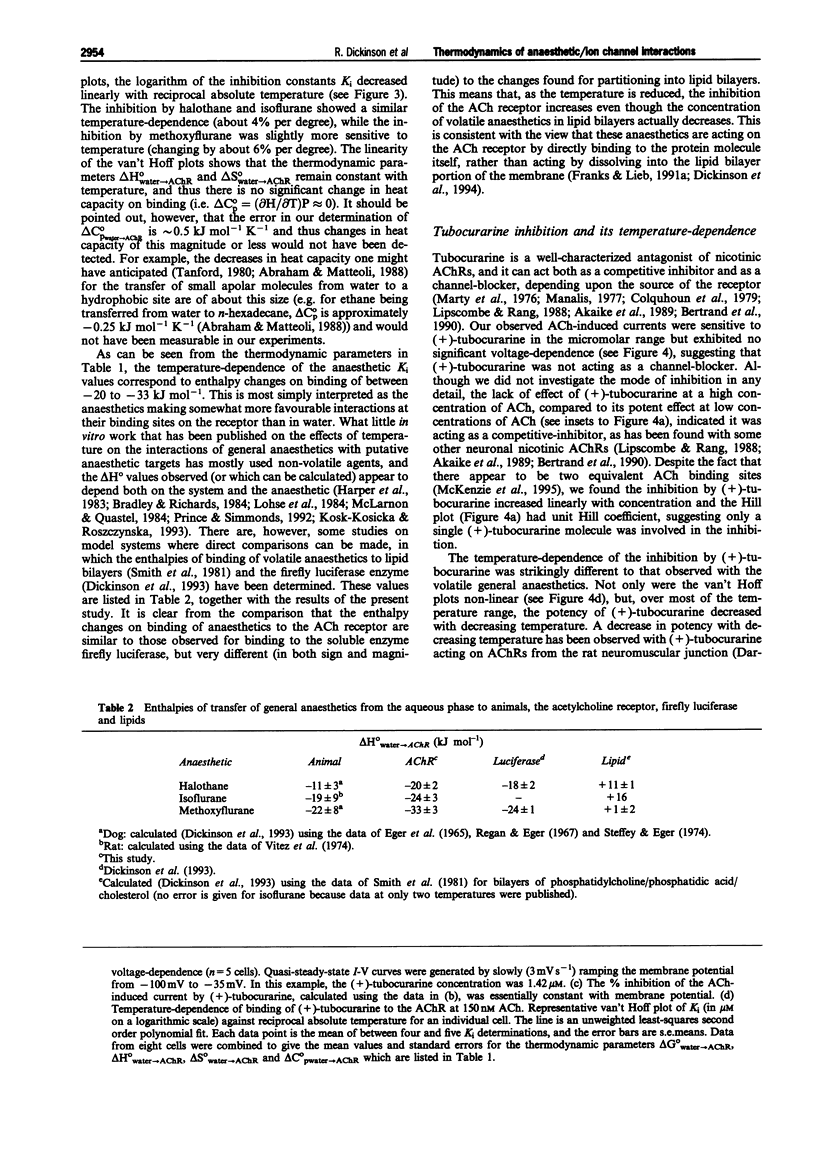
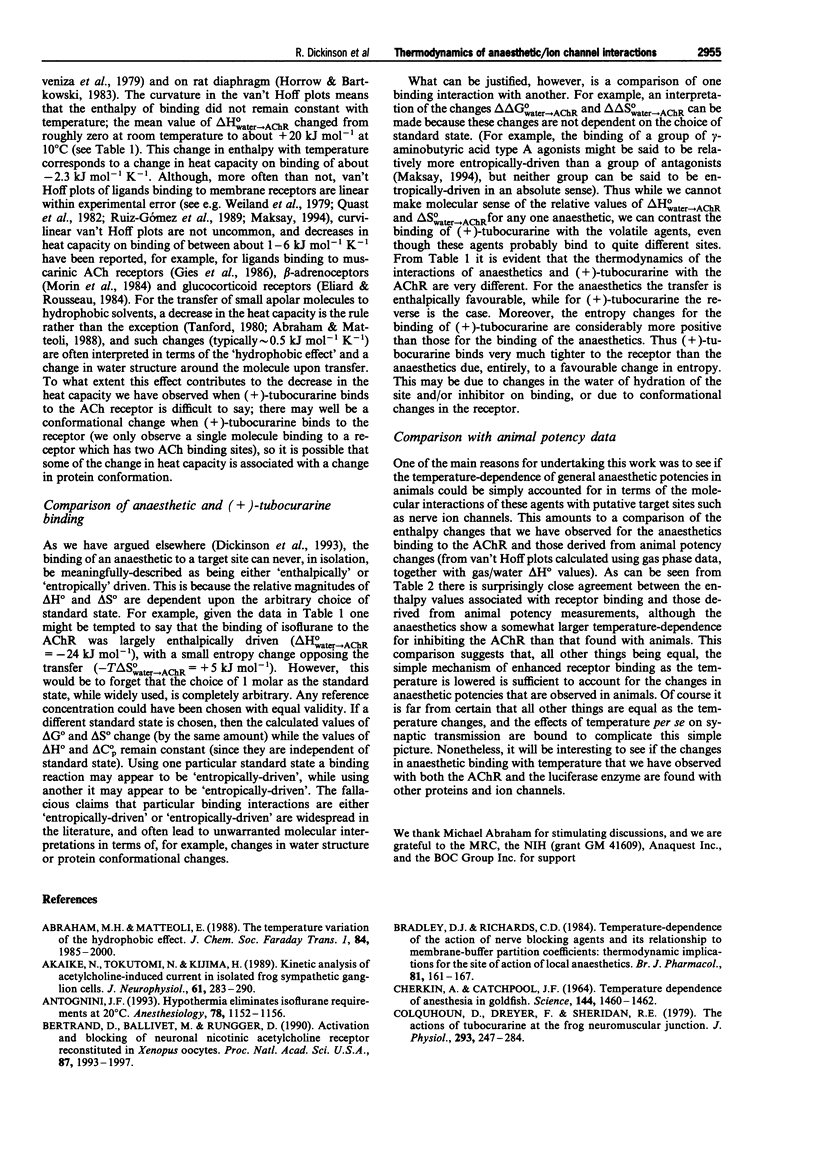
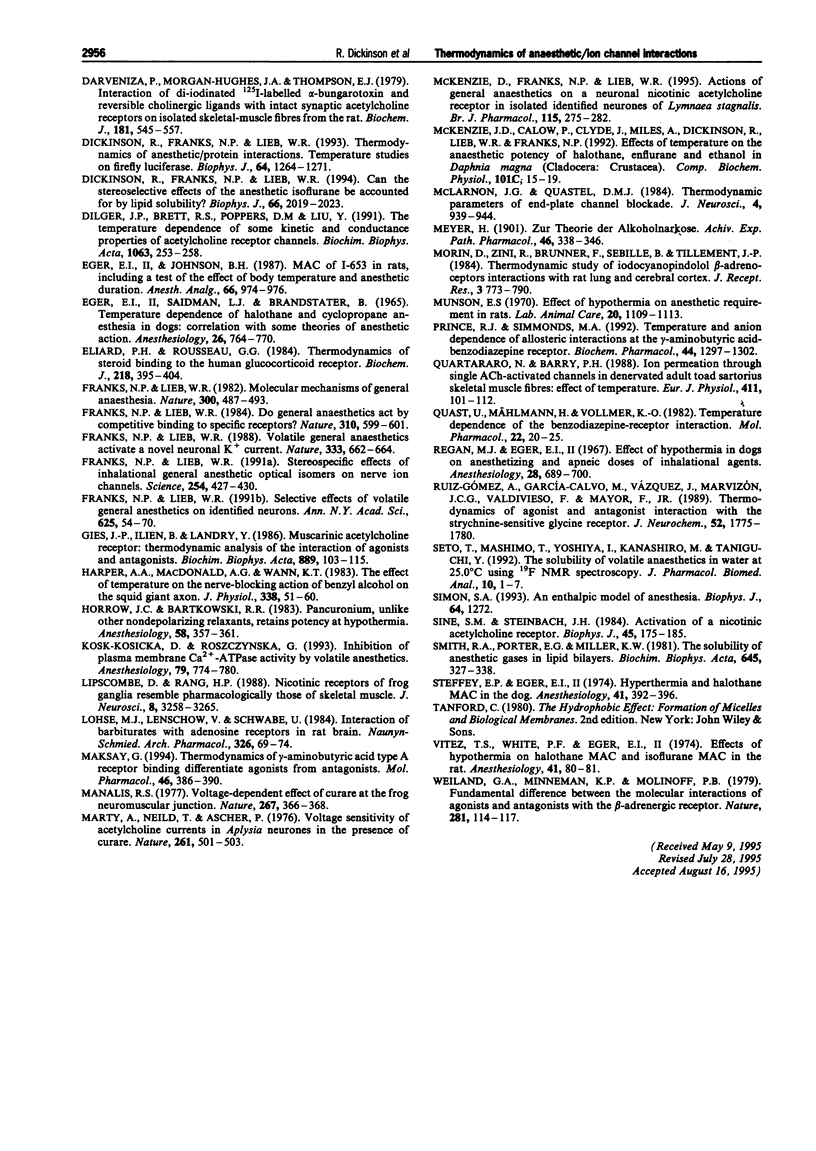
Selected References
These references are in PubMed. This may not be the complete list of references from this article.
- Akaike N., Tokutomi N., Kijima H. Kinetic analysis of acetylcholine-induced current in isolated frog sympathetic ganglion cells. J Neurophysiol. 1989 Feb;61(2):283–290. doi: 10.1152/jn.1989.61.2.283. [DOI] [PubMed] [Google Scholar]
- Antognini J. F. Hypothermia eliminates isoflurane requirements at 20 degrees C. Anesthesiology. 1993 Jun;78(6):1152–1156. doi: 10.1097/00000542-199306000-00020. [DOI] [PubMed] [Google Scholar]
- Bertrand D., Ballivet M., Rungger D. Activation and blocking of neuronal nicotinic acetylcholine receptor reconstituted in Xenopus oocytes. Proc Natl Acad Sci U S A. 1990 Mar;87(5):1993–1997. doi: 10.1073/pnas.87.5.1993. [DOI] [PMC free article] [PubMed] [Google Scholar]
- Bradley D. J., Richards C. D. Temperature-dependence of the action of nerve blocking agents and its relationship to membrane-buffer partition coefficients: thermodynamic implications for the site of action of local anaesthetics. Br J Pharmacol. 1984 Jan;81(1):161–167. doi: 10.1111/j.1476-5381.1984.tb10756.x. [DOI] [PMC free article] [PubMed] [Google Scholar]
- CHERKIN A., CATCHPOOL J. F. TEMPERATURE DEPENDENCE OF ANESTHESIA IN GOLDFISH. Science. 1964 Jun 19;144(3625):1460–1462. doi: 10.1126/science.144.3625.1460. [DOI] [PubMed] [Google Scholar]
- Colquhoun D., Dreyer F., Sheridan R. E. The actions of tubocurarine at the frog neuromuscular junction. J Physiol. 1979 Aug;293:247–284. doi: 10.1113/jphysiol.1979.sp012888. [DOI] [PMC free article] [PubMed] [Google Scholar]
- Darveniza P., Morgan-Hughes J. A., Thompson E. J. Interaction of di-iodinated 125I-labelled alpha-bungarotoxin and reversible cholinergic ligands with intact synaptic acetylcholine receptors on isolated skeletal-muscle fibres from the rat. Biochem J. 1979 Sep 1;181(3):545–557. doi: 10.1042/bj1810545. [DOI] [PMC free article] [PubMed] [Google Scholar]
- Dickinson R., Franks N. P., Lieb W. R. Can the stereoselective effects of the anesthetic isoflurane be accounted for by lipid solubility? Biophys J. 1994 Jun;66(6):2019–2023. doi: 10.1016/S0006-3495(94)80994-4. [DOI] [PMC free article] [PubMed] [Google Scholar]
- Dickinson R., Franks N. P., Lieb W. R. Thermodynamics of anesthetic/protein interactions. Temperature studies on firefly luciferase. Biophys J. 1993 Apr;64(4):1264–1271. doi: 10.1016/S0006-3495(93)81491-7. [DOI] [PMC free article] [PubMed] [Google Scholar]
- Dilger J. P., Brett R. S., Poppers D. M., Liu Y. The temperature dependence of some kinetic and conductance properties of acetylcholine receptor channels. Biochim Biophys Acta. 1991 Apr 2;1063(2):253–258. doi: 10.1016/0005-2736(91)90379-m. [DOI] [PubMed] [Google Scholar]
- Eger E. I., 2nd, Johnson B. H. MAC of I-653 in rats, including a test of the effect of body temperature and anesthetic duration. Anesth Analg. 1987 Oct;66(10):974–976. [PubMed] [Google Scholar]
- Eger E. I., 2nd, Saidman L. J., Brandstater B. Temperature dependence of halothane and cyclopropane anesthesia in dogs: correlation with some theories of anesthetic action. Anesthesiology. 1965 Nov-Dec;26(6):764–770. doi: 10.1097/00000542-196511000-00011. [DOI] [PubMed] [Google Scholar]
- Eliard P. H., Rousseau G. G. Thermodynamics of steroid binding to the human glucocorticoid receptor. Biochem J. 1984 Mar 1;218(2):395–404. doi: 10.1042/bj2180395. [DOI] [PMC free article] [PubMed] [Google Scholar]
- Franks N. P., Lieb W. R. Do general anaesthetics act by competitive binding to specific receptors? Nature. 1984 Aug 16;310(5978):599–601. doi: 10.1038/310599a0. [DOI] [PubMed] [Google Scholar]
- Franks N. P., Lieb W. R. Molecular mechanisms of general anaesthesia. Nature. 1982 Dec 9;300(5892):487–493. doi: 10.1038/300487a0. [DOI] [PubMed] [Google Scholar]
- Franks N. P., Lieb W. R. Selective effects of volatile general anesthetics on identified neurons. Ann N Y Acad Sci. 1991;625:54–70. doi: 10.1111/j.1749-6632.1991.tb33829.x. [DOI] [PubMed] [Google Scholar]
- Franks N. P., Lieb W. R. Stereospecific effects of inhalational general anesthetic optical isomers on nerve ion channels. Science. 1991 Oct 18;254(5030):427–430. doi: 10.1126/science.1925602. [DOI] [PubMed] [Google Scholar]
- Franks N. P., Lieb W. R. Volatile general anaesthetics activate a novel neuronal K+ current. Nature. 1988 Jun 16;333(6174):662–664. doi: 10.1038/333662a0. [DOI] [PubMed] [Google Scholar]
- Gies J. P., Ilien B., Landry Y. Muscarinic acetylcholine receptor: thermodynamic analysis of the interaction of agonists and antagonists. Biochim Biophys Acta. 1986 Oct 31;889(1):103–115. doi: 10.1016/0167-4889(86)90014-5. [DOI] [PubMed] [Google Scholar]
- Harper A. A., Macdonald A. G., Wann K. T. The effect of temperature on the nerve-blocking action of benzyl alcohol on the squid giant axon. J Physiol. 1983 May;338:51–60. doi: 10.1113/jphysiol.1983.sp014659. [DOI] [PMC free article] [PubMed] [Google Scholar]
- Horrow J. C., Bartkowski R. R. Pancuronium, unlike other nondepolarizing relaxants, retains potency at hypothermia. Anesthesiology. 1983 Apr;58(4):357–361. doi: 10.1097/00000542-198304000-00010. [DOI] [PubMed] [Google Scholar]
- Kosk-Kosicka D., Roszczynska G. Inhibition of plasma membrane Ca(2+)-ATPase activity by volatile anesthetics. Anesthesiology. 1993 Oct;79(4):774–780. doi: 10.1097/00000542-199310000-00020. [DOI] [PubMed] [Google Scholar]
- Lipscombe D., Rang H. P. Nicotinic receptors of frog ganglia resemble pharmacologically those of skeletal muscle. J Neurosci. 1988 Sep;8(9):3258–3265. doi: 10.1523/JNEUROSCI.08-09-03258.1988. [DOI] [PMC free article] [PubMed] [Google Scholar]
- Lohse M. J., Lenschow V., Schwabe U. Interaction of barbiturates with adenosine receptors in rat brain. Naunyn Schmiedebergs Arch Pharmacol. 1984 May;326(1):69–74. doi: 10.1007/BF00518781. [DOI] [PubMed] [Google Scholar]
- Maksay G. Thermodynamics of gamma-aminobutyric acid type A receptor binding differentiate agonists from antagonists. Mol Pharmacol. 1994 Aug;46(2):386–390. [PubMed] [Google Scholar]
- Manalis R. S. Voltage-dependent effect of curare at the frog neuromuscular junction. Nature. 1977 May 26;267(5609):366–368. doi: 10.1038/267366a0. [DOI] [PubMed] [Google Scholar]
- Marty A., Neild T., Ascher P. Voltage sensitivity of acetylcholine currents in Aplysia neurones in the presence of curare. Nature. 1976 Jun 10;261(5560):501–503. doi: 10.1038/261501a0. [DOI] [PubMed] [Google Scholar]
- McKenzie D., Franks N. P., Lieb W. R. Actions of general anaesthetics on a neuronal nicotinic acetylcholine receptor in isolated identified neurones of Lymnaea stagnalis. Br J Pharmacol. 1995 May;115(2):275–282. doi: 10.1111/j.1476-5381.1995.tb15874.x. [DOI] [PMC free article] [PubMed] [Google Scholar]
- McKenzie J. D., Calow P., Clyde J., Miles A., Dickinson R., Lieb W. R., Franks N. P. Effects of temperature on the anaesthetic potency of halothane, enflurane and ethanol in Daphnia magna (Cladocera: Crustacea). Comp Biochem Physiol C. 1992;101(1):15–19. doi: 10.1016/0742-8413(92)90193-b. [DOI] [PubMed] [Google Scholar]
- McLarnon J. G., Quastel D. M. Thermodynamic parameters of end-plate channel blockade. J Neurosci. 1984 Apr;4(4):939–944. doi: 10.1523/JNEUROSCI.04-04-00939.1984. [DOI] [PMC free article] [PubMed] [Google Scholar]
- Morin D., Zini R., Brunner F., Sebille B., Tillement J. P. Thermodynamic study of iodocyanopindolol beta-adrenoceptors interactions with rat lung and cerebral cortex. J Recept Res. 1983;3(6):773–790. doi: 10.3109/10799898309041959. [DOI] [PubMed] [Google Scholar]
- Munson E. S. Effect of hypothermia on anesthetic requirement in rats. Lab Anim Care. 1970 Dec;20(6):1109–1113. [PubMed] [Google Scholar]
- Prince R. J., Simmonds M. A. Temperature and anion dependence of allosteric interactions at the gamma-aminobutyric acid-benzodiazepine receptor. Biochem Pharmacol. 1992 Oct 6;44(7):1297–1302. doi: 10.1016/0006-2952(92)90529-r. [DOI] [PubMed] [Google Scholar]
- Quartararo N., Barry P. H. Ion permeation through single ACh-activated channels in denervated adult toad sartorius skeletal muscle fibres: effect of temperature. Pflugers Arch. 1988 Jan;411(1):101–112. doi: 10.1007/BF00581653. [DOI] [PubMed] [Google Scholar]
- Quast U., Mählmann H., Vollmer K. O. Temperature dependence of the benzodiazepine-receptor interaction. Mol Pharmacol. 1982 Jul;22(1):20–25. [PubMed] [Google Scholar]
- Regan M. J., Eger E. I., 2nd Effect of hypothermia in dogs on anesthetizing and apneic doses of inhalation agents. Determination of the anesthetic index (Apnea/MAC). Anesthesiology. 1967 Jul-Aug;28(4):689–700. doi: 10.1097/00000542-196707000-00015. [DOI] [PubMed] [Google Scholar]
- Ruiz-Gómez A., García-Calvo M., Vázquez J., Marvizón J. C., Valdivieso F., Mayor F., Jr Thermodynamics of agonist and antagonist interaction with the strychnine-sensitive glycine receptor. J Neurochem. 1989 Jun;52(6):1775–1780. doi: 10.1111/j.1471-4159.1989.tb07256.x. [DOI] [PubMed] [Google Scholar]
- Simon S. A. An enthalpic model of anesthesia. Biophys J. 1993 Apr;64(4):1272–1272. doi: 10.1016/S0006-3495(93)81460-7. [DOI] [PMC free article] [PubMed] [Google Scholar]
- Sine S. M., Steinbach J. H. Activation of a nicotinic acetylcholine receptor. Biophys J. 1984 Jan;45(1):175–185. doi: 10.1016/S0006-3495(84)84146-6. [DOI] [PMC free article] [PubMed] [Google Scholar]
- Smith R. A., Porter E. G., Miller K. W. The solubility of anesthetic gases in lipid bilayers. Biochim Biophys Acta. 1981 Jul 20;645(2):327–338. doi: 10.1016/0005-2736(81)90204-2. [DOI] [PubMed] [Google Scholar]
- Steffey E. P., Eger E. I., 2nd Hyperthermia and halothane MAC in the dog. Anesthesiology. 1974 Oct;41(4):392–396. doi: 10.1097/00000542-197410000-00017. [DOI] [PubMed] [Google Scholar]
- Vitez T. S., White P. F., Eger E. I., 2nd Effects of hypothermia on halothane MAC and isoflurane MAC in the rat. Anesthesiology. 1974 Jul;41(1):80–81. doi: 10.1097/00000542-197407000-00020. [DOI] [PubMed] [Google Scholar]
- Weiland G. A., Minneman K. P., Molinoff P. B. Fundamental difference between the molecular interactions of agonists and antagonists with the beta-adrenergic receptor. Nature. 1979 Sep 13;281(5727):114–117. doi: 10.1038/281114a0. [DOI] [PubMed] [Google Scholar]


